Struggling with low deliverability, bounced messages, or emails landing in spam? You’re not alone. Whether you’re sending transactional receipts, marketing newsletters, or critical account alerts, unreliable SMTP servers can derail your communication.
Imagine this: Your carefully crafted welcome series never even reaches a customer’s inbox, or time-sensitive notifications arrive too late. Frustrating, right? The good news is, the right SMTP service can turn those failures into flawless, on-time deliveries.
In this guide, we’ll tackle the most common SMTP challenges—spam filters, rate limits, lackluster analytics, and show you exactly how the 10 best SMTP servers and services in 2025 overcome them. You’ll get:
- Real-world deliverability data so you know which providers consistently hit the inbox.
- Integration tips for every platform, from PHP and Node.js to WordPress and Shopify.
- Feature breakdowns that let you compare sending limits, security protocols, and pricing at a glance.
Say goodbye to unpredictable email performance. Let’s dive into the top SMTP solutions that keep your messages moving securely, reliably, and hassle-free.
Quick Comparison Table of Best SMTP Services
| SMTP Provider | Free Tier | Best For | Key Pros | Starting Price |
|---|---|---|---|---|
| Brevo | 300 emails/day | Small businesses & marketers | Easy setup, CRM tools, good analytics | Free, Paid from $9/mo |
| MailerSend | 3,000 emails/mo | Developers & SaaS | Clean UI, team collaboration, solid API | Free, Paid from $35/mo |
| SMTP2GO | 1,000 emails/mo | Global delivery | High deliverability, 24/7 support | Free, Paid from $15/mo |
| SendPulse | 12,000 emails/mo | Startups & automation | Multi-channel tools, generous free tier | Free, Paid from $8.85/mo |
| Mailjet | 6,000 emails/mo | Agencies & teams | Team collaboration, GDPR-compliant | Free, Paid from $17/mo |
| SendGrid | 100 emails/day | Scalable transactions | Developer-friendly, robust API, analytics | Free, Paid from $19.95/mo |
| AhaSend | Free 1,000 emails | Email beginners | Easy builder, email warmup, value-packed | Free, Paid from $5/mo |
| Mailgun | 100 emails/day | High-volume use | Powerful API, tracking, deliverability | Paid from $15/mo |
| Postmark | 100 emails/mo | Fast transactional email | Fast delivery, detailed logs, clean API | Paid from $15/mo |
| turboSMTP | 6,000 emails/mo | Freelancers & bloggers | Simple setup, cost-effective, API-ready | Free, Paid from $14.95/mo |
How We Selected & Tested These SMTP Services?
With dozens of SMTP services out there—each promising better deliverability, more features, and “unmatched reliability”—we knew a simple comparison wouldn’t cut it. So instead of just listing specs, we rolled up our sleeves and actually tested these platforms in real-world scenarios.
Here’s how we did it:
Selection Criteria
We shortlisted SMTP providers based on what actually matters to businesses and developers in 2025:
- Inbox Deliverability: Do emails land in inboxes—or get flagged as spam or bounce entirely?
- Ease of Setup: How quickly can a beginner get started? Do the platforms offer good documentation and onboarding?
- Analytics & Reporting: Can you track opens, bounces, and engagement easily without needing third-party tools?
- Scalability & Pricing: Whether you’re sending 100 emails/day or 1 million/month, does the platform offer pricing that grows with you?
- Security Standards: Is SPF, DKIM, and DMARC setup seamless? Are the platforms compliant with major data and security regulations?
- Support Quality: Is help actually available when something breaks—or are you left waiting in a ticket queue?
Testing Process
To keep things fair and measurable, we used the same process for every SMTP service:
- Setup & Onboarding Test: We signed up, added domains, and integrated with test email clients. Platforms that guided us through SPF/DKIM setup got extra points.
- Deliverability Check: Each service was tested by sending emails to a controlled set of inboxes (Gmail, Outlook, Yahoo, etc.) and monitoring spam folder hits, bounce rates, and open rates using tools like Mail-Tester and GlockApps.
- Volume & Throttling Test: We sent batches of emails in quick succession to see how each service handled volume and rate limiting. This helped us identify platforms best suited for bulk senders.
- Analytics & API Evaluation: We explored the reporting dashboard, tested their APIs, and checked how easily we could track user actions like opens, clicks, and unsubscribes.
- Customer Support Test: We contacted support with common setup and deliverability issues, then rated them based on speed, clarity, and helpfulness of their responses.
Bottom line? We didn’t just compare SMTP services on paper—we put them through the wringer so you don’t have to.
Detailed Analysis of Best SMTP Services
1. Brevo (formerly Sendinblue)
Brevo makes email sending simple—especially for startups, solopreneurs, and small businesses that want reliable transactional emails without burning through budgets. It offers one of the best SMTP services in the market today, balancing affordability with powerful features. Whether you’re sending password resets or order confirmations, Brevo’s SMTP relay servers are built to ensure dependable delivery at scale.
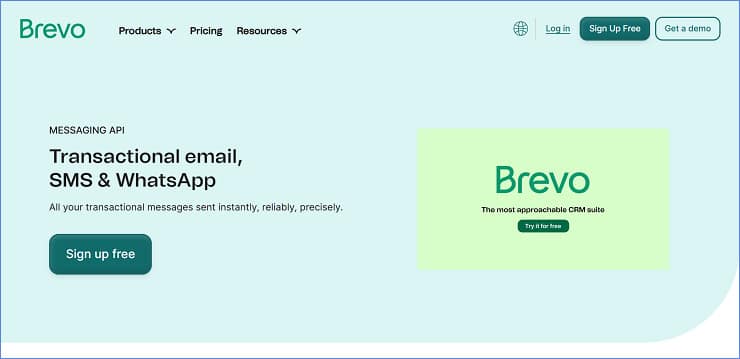
Brevo Pros
- Generous Free Tier: Send up to 300 emails/day for free—perfect for light transactional needs.
- Full Marketing Suite Included: Unlike many SMTP service providers, Brevo throws in automation, SMS, and CRM tools.
- Real-Time Reporting: Easily track email opens, clicks, and bounces in one clean dashboard.
- SMTP Server Integration: Quick setup with major platforms like WordPress, WooCommerce, and Shopify.
- GDPR-Compliant & Secure: Brevo is built with privacy-first protocols for peace of mind.
Brevo Cons
- Daily Sending Limit on Free Plan: Can be restrictive for fast-growing businesses.
- Shared IP Addresses: Unless you upgrade, you’ll be sending via shared SMTP servers, which may affect deliverability.
- Support Could Be Faster: Email support is only on the free plan; live chat comes with paid tiers.
Brevo Pricing Snapshot
| Plan | Daily/Monthly Emails | Starting Price | Dedicated IP |
|---|---|---|---|
| Free | 300/day (9,000/month) | $0 | – |
| Starter | 5,000/month | $9 /mo | Optional Add-on |
| Business | 5,000/month | $19 /mo | Optional Add-on |
| Enterprise | Custom Volume | Contact Sales | Included |
Bottom line: Brevo is a go-to pick if you're looking for a beginner-friendly, affordable, and multi-functional SMTP service provider. It's one of the best SMTP servers for anyone who needs both marketing and transactional tools in one place.
2. MailerSend
MailerSend is like the cool younger sibling of MailerLite—built specifically for transactional emails. It’s one of the best SMTP services for developers who want flexibility without the fuss and for teams that need intuitive tools, clean APIs, and reliable SMTP servers. If you’re a growing startup or SaaS company looking to scale fast and smart, MailerSend should be on your radar.

MailerSend Pros
- Generous Free Tier: Send up to 3,000 emails/month for free, with access to core features.
- Developer-Friendly API & Webhooks: Built for modern workflows with RESTful API, templating, and full webhook support.
- Collaborative Tools: Multiple users, roles, and a clean UI make it easy for marketing and tech teams to work together.
- Inbuilt Templates & Drag-and-Drop Editor: Design transactional emails with ease—no extra tools needed.
- Advanced Analytics: Track opens, clicks, bounces, and more in real-time.
MailerSend Cons
- Still Maturing: Newer to the SMTP service provider landscape, so lacks some deep enterprise features offered by bigger players.
- Limited Deliverability Tools: Dedicated IPs and advanced reputation management options are still in the works.
- Support Availability: No phone support; live chat is limited to business hours.
MailerSend Pricing Snapshot
| Plan | Monthly Emails | Starting Price | Dedicated IP |
|---|---|---|---|
| Free | 3,000 | $0 | – |
| Starter | 50,000/mo | $35 /mo | – |
| Professional | 50,000/mo | $35 /mo | – |
| Enterprise | Custom | Contact Sales | Included |
Bottom line: MailerSend is a modern, no-fluff SMTP service provider that does transactional email right. It’s fast, flexible, and ideal for developers and startups who want smart features without bloated costs. A rising star among SMTP relay servers.
3. SMTP2GO
SMTP2GO lives up to its name—it’s an SMTP service built for speed, reliability, and, yes, going global. Whether you’re sending from the office, on a remote server, or while traveling, this platform ensures your emails get delivered without fail. Among the best SMTP services, SMTP2GO is particularly well-suited for businesses that need consistent uptime, strong deliverability, and 24/7 support.
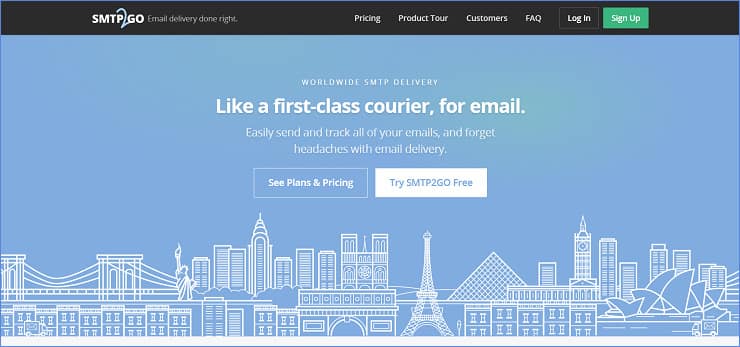
SMTP2GO Pros
- Worldwide Server Network: Optimized routing across global SMTP servers helps reduce latency and boost delivery rates.
- Real-Time Reporting: Get instant insights on opens, clicks, bounces, and spam complaints—without needing extra tools.
- Built-In Email Testing Tools: Preview your emails, check blacklist status, and verify domain health all in one place.
- Strong Uptime & Failover Systems: Redundant SMTP relay servers ensure email sending even if one server fails.
- 24/7 Live Support: Yes, actual humans—available any time, even on free plans.
SMTP2GO Cons
- Free Plan Is Quite Limited: Only 1,000 emails/month—may not be ideal for growing businesses.
- UI Feels a Bit Dated: Functionally solid, but not the most modern or visually sleek dashboard.
- No Drag-and-Drop Email Builder: Strictly an SMTP service – no marketing email tools included.
SMTP2GO Pricing Snapshot
| Plan | Monthly Emails | Starting Price | Dedicated IP |
|---|---|---|---|
| Free | 1,000 | $0 | – |
| Starter | 10,000/mo | $15 /mo | – |
| Professional | 100,000/mo | $75 /mo | Included |
| Premier Custom | 3,000,000+ | Contact Sales | Included |
Bottom line: SMTP2GO is one of the best SMTP service providers for teams who want rock-solid uptime, global infrastructure, and actual human support. It may not have all the bells and whistles, but as far as reliable SMTP relay servers go, it’s hard to beat.
4. SendPulse
SendPulse is more than just a bulk email marketing platform—it offers a powerful transactional email engine that competes with the best SMTP services out there. Whether you’re sending order confirmations, password resets, or critical alerts, its SMTP relay servers ensure smooth and fast delivery. Best suited for businesses that want a combination of marketing tools and dependable SMTP servers under one roof.
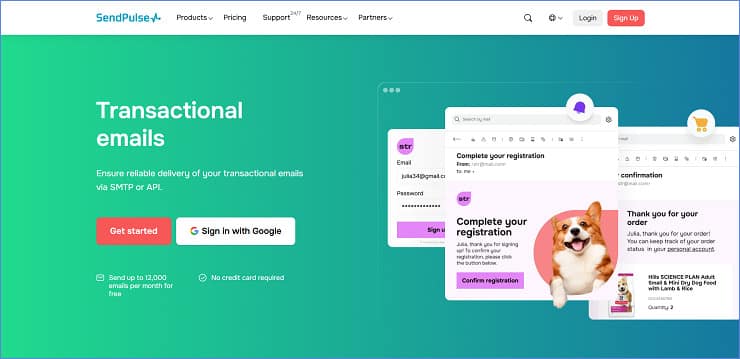
SendPulse Pros
- Robust Free Plan: Send up to 12,000 emails/month with access to SMTP features.
- Easy SMTP Integration: Set up your SMTP credentials quickly—compatible with most CMS, CRMs, and third-party apps.
- Smart Analytics: Get delivery stats, bounce rates, open/click tracking, and heatmaps in real-time.
- Prebuilt Templates: Use responsive email templates to create professional-looking transactional messages easily.
- Multiple Channels: Comes bundled with email marketing, push notifications, chatbots, and SMS tools—great for omnichannel communication.
SendPulse Cons
- Dashboard Can Feel Overcrowded: With so many tools, the interface isn’t as minimal as dedicated SMTP service providers.
- Limited Customization on Free Plan: Some features like automation workflows are reserved for paid tiers.
- Deliverability Fluctuates: Shared IPs on the free plan may cause occasional delays.
SendPulse Pricing Snapshot
| Plan | Monthly Emails | Starting Price | Dedicated IP |
|---|---|---|---|
| Free | 12,000 | $0 | – |
| Basic | 25,000+ | $8.85 /mo | – |
| Pro | 100,000+ | $74.85 /mo | Included |
| Enterprise | 500,000+ | 274.86 /mo | Included |
Bottom line: SendPulse stands out as a versatile SMTP service provider for growing teams who want both marketing automation and reliable transactional email delivery. It’s one of the few SMTP relay servers that gives you value and volume in a single package.
5. Mailjet
Mailjet is a well-established player in the world of SMTP service providers, offering a balanced mix of simplicity, scalability, and strong deliverability. Whether you’re a startup sending order confirmations or an enterprise delivering millions of transactional emails, Mailjet’s SMTP relay servers are engineered to get your message through. It’s one of the best SMTP services for teams that need a flexible, reliable solution without getting buried in tech complexity.

Mailjet Pros
- Fast SMTP Setup: You can start sending emails within minutes using Mailjet’s pre-configured SMTP servers.
- Strong Deliverability Infrastructure: Backed by global servers and proactive reputation monitoring.
- Real-Time Email Analytics: View opens, clicks, bounces, and more, all in one clear dashboard.
- User Permissions & Collaboration Tools: Built for teams, with multi-user access and role management.
- GDPR-Compliant & ISO Certified: Security and privacy baked in from the ground up.
Mailjet Cons
- No Drag-and-Drop for Transactional Emails: You’ll need to bring your own HTML or use templating.
- Basic Free Plan: Limits features like segmentation and advanced stats.
- Support Can Be Tiered: Premium support is reserved for higher-tier plans.
Mailjet Pricing Snapshot
| Plan | Monthly Emails | Starting Price | Dedicated IP |
|---|---|---|---|
| Free | 6,000 (200/day) | $0 | – |
| Essential | 15,000 | $17 /mo | – |
| Premium | 15,000+ | $27 /mo | – |
| Custom | Custom Volume | Contact Sales | Included |
Bottom line: Mailjet is a no-nonsense, high-performance SMTP service provider that handles both transactional and marketing emails under one roof. Its reliable SMTP servers and strong API support make it one of the best SMTP services for growing businesses that want flexibility without losing focus.
6. SendGrid
SendGrid is practically a household name when it comes to email delivery—and for good reason. As one of the most widely used SMTP service providers globally, it offers unmatched scalability and deliverability through robust SMTP servers and a powerful email API. It’s backed by Twilio, which adds an extra layer of trust and infrastructure stability.
From small businesses to enterprise-level apps, SendGrid is ideal for anyone looking to send large volumes of transactional or marketing emails reliably. Whether you’re sending password resets, shipping updates, or promotional blasts, SendGrid’s SMTP relay servers make sure it lands in the inbox—fast.

SendGrid Pros
- High-Volume Scalability: Easily handles millions of emails per month.
- Strong Deliverability Track Record: Advanced tools to optimize your sender reputation.
- Flexible SMTP & API Support: Plug and play with virtually any tech stack.
- Built-in Email Validation: Reduce bounce rates with real-time verification.
- Trusted by Big Brands: Used by Uber, Spotify, Airbnb, and other top-tier companies.
SendGrid Cons
- Not Beginner-Friendly: The dashboard and settings may overwhelm first-time users.
- Limited Features on Free Plan: Essentials like dedicated IPs require upgrades.
- Support Prioritized by Plan: Premium support is paywalled.
SendGrid Pricing Snapshot
| Plan | Monthly Emails | Starting Price | Dedicated IP |
|---|---|---|---|
| Free | 100/day | $0 | – |
| Essentials | 50,000-100,000 | $19.95 /mo | – |
| Pro | 100,000-2,500,000 | $89.95 /mo | Included |
| Premier | Custom Volume | Contact Sales | Included + SLA |
Bottom line: SendGrid continues to rank among the best SMTP services for its ability to deliver at scale, support complex email needs, and provide rock-solid infrastructure. Its SMTP servers are built to grow with your business, whether you're just getting started or sending millions of emails every month.
7. AhaSend
AhaSend may not be a household name yet, but it’s quietly becoming a go-to choice for businesses that want reliable, privacy-focused SMTP servers without the inflated price tag. Designed for only for transactional emails, AhaSend brings simplicity, speed, and straightforward pricing to the table. If you’re looking for one of the best SMTP services with zero fluff and full GDPR compliance, this is a solid contender.
Whether you’re sending account alerts, OTPs, or eCommerce order updates, AhaSend’s SMTP relay servers are built to deliver with precision. It’s particularly appealing to privacy-conscious startups and SMBs who want a no-nonsense alternative to bulkier SMTP service providers.
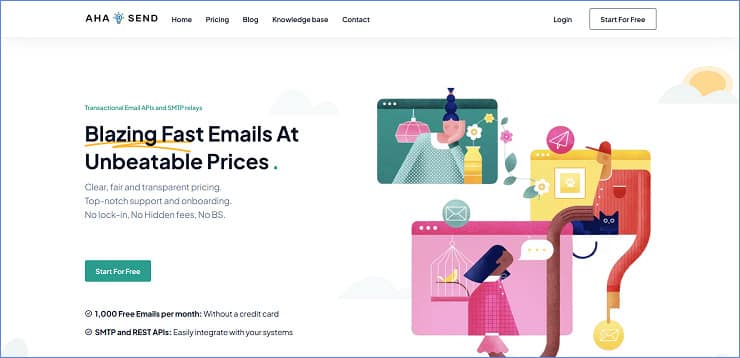
AhaSend Pros
- GDPR-Friendly and Fully Compliant: European data centers with strict privacy protocols.
- Easy SMTP Configuration: Send emails within minutes using simple SMTP relay server settings.
- High Email Deliverability: Optimized infrastructure to reduce bounce rates and improve inbox placement.
- Affordable Flat Pricing: Transparent cost structure without surprise upgrades.
- Detailed Email Logs: Track everything with easy-to-understand logs and stats.
AhaSend Cons
- Fewer Integrations Compared to Larger Players: You might need some workarounds.
- No Drag-and-Drop Email Builder: Not ideal for those who need a visual editor for email content.
- Limited Marketing Features: AhaSend is primarily focused on transactional emails.
AhaSend Pricing Snapshot
| Plan | Monthly Emails | Starting Price | Dedicated IP |
|---|---|---|---|
| Free | 1,000 | $0 | – |
| Pay As You Go | Starts at 10,000/mo | $5 /mo | Available for 300,000+ email senders |
Bottom line: AhaSend is one of the most underrated SMTP service providers in the market today. If you're after a clean, privacy-first platform with robust SMTP relay servers and great value, it deserves a top spot among the best SMTP services of 2025.
8. Mailgun
Mailgun is a powerhouse in the world of email infrastructure, especially if you’re a developer, startup, or tech-driven business that sends large volumes of transactional emails. Its developer-first approach, scalable SMTP servers, and in-depth analytics make it a top-tier choice among the best SMTP services in 2025.
Whether you’re handling password resets, app notifications, or marketing automation, Mailgun’s reliable SMTP relay servers ensure your emails land in the inbox, not the spam folder. It’s a favorite among SaaS platforms, eCommerce brands, and developers who want fine-grained control without compromising on speed or deliverability.
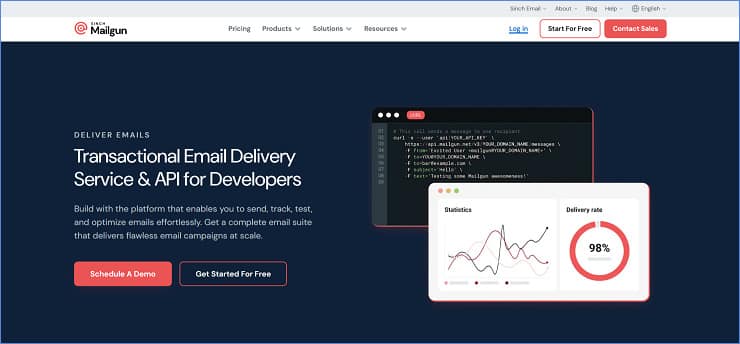
Mailgun Pros
- High Deliverability with Dedicated IP Pools: Designed to maintain sender reputation and improve inbox placement.
- Powerful Email API & SMTP Support: Flexibility to switch between API and SMTP relay servers on demand.
- Advanced Analytics & Email Logs: Real-time data and logs for deep insights into performance.
- Email Verification Tool: Prevents bad addresses from clogging your list.
- Scalable Infrastructure: Trusted by companies sending millions of emails per day.
Mailgun Cons
- Not Beginner-Friendly: Best suited for users with some technical know-how.
- Support Tiers Vary: Premium support is reserved for higher plans.
- No Visual Email Builder: Strictly for transactional and programmatic emails.
Mailgun Pricing Snapshot
| Plan | Monthly Emails | Starting Price | Dedicated IP |
|---|---|---|---|
| Free | 100 /day | $0 | – |
| Basic | 10,000 /mo | $15 /mo | – |
| Foundation | 50,000 /mo | $35 /mo | Available for high volume senders |
| Scale | 100,000/mo | $90 /mo | Included |
Bottom line: If you’re a developer or business that values speed, control, and top-notch analytics, Mailgun is one of the best SMTP service providers to consider. With its powerful SMTP servers and scalable infrastructure, it’s a smart pick for teams that want reliable delivery at scale.
9. Postmark
If speed, transparency, and rock-solid deliverability are your top priorities, Postmark is a name you’ll want to bookmark. Unlike many SMTP service providers that lump transactional and marketing emails together, Postmark keeps them strictly separate, ensuring your mission-critical messages like password resets and OTPs always get VIP treatment.
Postmark’s lightning-fast SMTP servers and commitment to best practices make it a standout among the best SMTP services available in 2025. It’s a developer-favorite and an excellent option for SaaS apps, product notifications, and any brand that refuses to compromise on delivery speed or inbox placement.
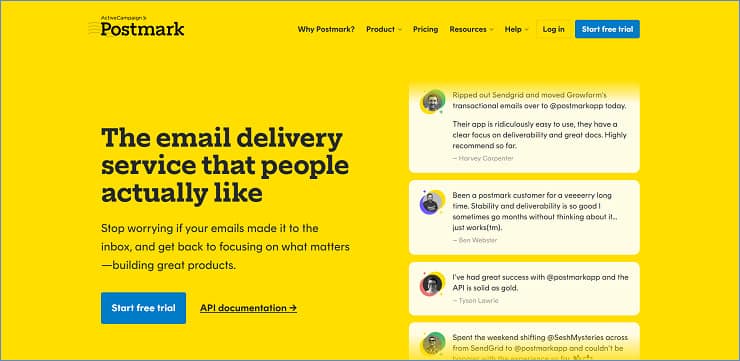
Postmark Pros
- Unmatched Email Speed: Often delivers emails in under 10 seconds, thanks to optimized SMTP relay servers.
- Transactional-Only Focus: Keeps deliverability high by separating promotional traffic.
- Detailed Activity Logs: Pinpoint issues and monitor performance with real-time visibility.
- Simple Setup: Start sending via SMTP or API in just a few minutes.
- Superb Reputation Management: High sender reputation across all IPs.
Postmark Cons
- Not Meant for Bulk Marketing: No support for newsletters or promotional campaigns.
- Pricey at Scale: Gets expensive if you’re sending a large volume of emails regularly.
- Fewer Integrations: Not as wide-ranging as some competitors.
Postmark Pricing Snapshot
| Plan | Monthly Emails | Starting Price | Dedicated IP |
|---|---|---|---|
| Free | 100 /mo | $0 | – |
| Basic | 10,000 | $15 /mo | – |
| Pro | 50,000 | $60.50 /mo | Optional Add-on |
| Platform | 125,000 | $138 /mo | Optional Add-on |
Bottom line: Postmark is one of the most trusted SMTP service providers when it comes to fast, reliable, and secure transactional email delivery. If you're looking for a focused, high-performing solution among the best SMTP services, Postmark delivers fast and flawlessly.
10. turboSMTP
If you’re on the lookout for a simple yet reliable SMTP service provider that “just works,” turboSMTP is worth considering. Tailored especially for bloggers, small businesses, and freelancers, turboSMTP focuses on hassle-free email delivery with a strong emphasis on usability and inbox success.
What sets turboSMTP apart is its dedicated attention to inbox placement and consistent uptime. Its SMTP relay servers are optimized to ensure your transactional and marketing emails reach their destination without unnecessary complexity. Whether you’re sending newsletters, contact form replies, or system-generated alerts, turboSMTP helps you keep communication sharp and spam-free.
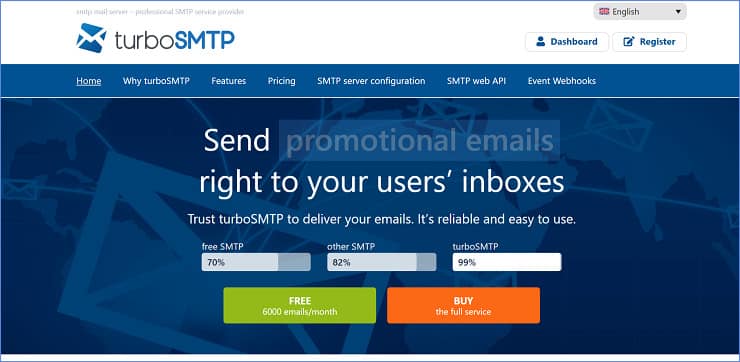
turboSMTP Pros
- Straightforward Setup: Start sending emails via SMTP servers in minutes—no tech wizardry required.
- High Inbox Delivery Rate: Strong reputation with ISPs helps avoid spam folders.
- 24/7 Customer Support: Get help anytime, even on the free plan.
- Flexible Email Plans: Pay-as-you-go and monthly subscriptions available.
- Works with Any Email Client: Full compatibility with Outlook, Thunderbird, WordPress, and more.
turboSMTP Cons
- Lacks Advanced Analytics: Basic reporting tools compared to top-tier competitors.
- Limited Free Plan: Free tier comes with branding and limited daily quota.
- No Marketing Automation Features: Strictly for sending emails—no built-in workflows or email builders.
turboSMTP Pricing Snapshot
| Plan | Monthly Emails | Starting Price | Dedicated IP |
|---|---|---|---|
| Free | 6,000/mo | $0 | – |
| Basic | 20,000 | $14.95 /mo | – |
| Professional | 100,000+ | From $79.95 /mo | Included |
| Enterprise | 2,000,000+ | Contact Sales | Included |
Bottom line: turboSMTP isn’t the flashiest name in the industry, but it earns its place among the best SMTP services with reliable delivery, excellent support, and user-friendly SMTP servers. If you need an uncomplicated, budget-friendly solution that just gets your emails delivered, this one’s got your back.
Deep Dive: Deliverability Best Practices
So you’ve picked one of the best SMTP services – great start. But here’s the hard truth: even with the most powerful SMTP servers, if your emails aren’t landing in the inbox, it’s all for nothing.
Deliverability is the name of the game. And while top-tier SMTP service providers handle a lot on their end, there are still a few best practices you should absolutely follow on yours.
Let’s break down the essential deliverability moves that’ll keep your emails out of the spam folder and right where they belong, front and center in your recipient’s inbox.
Email Authentication: SPF, DKIM & DMARC
Think of these as your email’s passport and security clearance. Authentication proves to ISPs (like Gmail, Outlook, etc.) that your message is legit and not some shady spam attempt.
- SPF (Sender Policy Framework): This tells receiving servers which IPs are allowed to send on your domain’s behalf.
- DKIM (DomainKeys Identified Mail): Adds a cryptographic signature to your emails to verify they weren’t tampered with en route.
- DMARC (Domain-based Message Authentication, Reporting & Conformance): Acts like a bouncer that tells email servers what to do if SPF and DKIM checks fail—and provides reports so you can monitor suspicious activity.
Most of the SMTP service providers we covered offer guided setup for SPF, DKIM, and DMARC. Don’t skip this—it’s critical for inbox placement and protecting your domain’s reputation.
Keep Your List Squeaky Clean (List Hygiene & Engagement)
One of the biggest deliverability killers? Sending emails to people who never open them—or worse, marking them as spam.
Here’s how to keep things healthy:
- Regularly clean your email list (remove inactive users, invalid emails, bounces)
- Use double opt-in where possible
- Monitor open and click rates
- Purge disengaged users after 60-90 days
Pro Tip: Most SMTP relay servers now offer engagement tracking. Use that data to segment users and only message the people who want to hear from you.
Watch Your Sending Behavior (Throttling & Rate Limits)
Even the best SMTP services come with limits—go beyond them, and you’ll raise red flags.
- Throttling means spacing out large email sends to avoid looking spammy.
- Rate limits vary by provider and plan—check your quota before blasting out 100K emails in an hour.
- Ramp up gradually if you’re using a new IP or domain (this is called IP warm-up).
Why does it matters? Email providers like Gmail and Yahoo are always watching your sending behavior. Sudden spikes or shady patterns = straight to spam.
Cost Optimization Strategies
Let’s be honest—email isn’t just a marketing channel, it’s a budget line. And if you’re sending high volumes or scaling fast, the cost of using even the best SMTP services can add up. But the good news? There are smart ways to manage your spend without sacrificing deliverability, speed, or features.
Here’s how to get the most bang for your buck from your SMTP servers—whether you’re on a budget or just want to avoid paying for features you don’t need (yet).
When to Upgrade vs. Stick with the Free Tier
Most SMTP service providers offer free tiers—and if you’re a startup, solopreneur, or just dipping your toes into transactional emails, that’s more than enough to get started.
Stick to the free tier if:
- You’re sending under ~300 emails/day or ~10,000/month
- You don’t need dedicated IPs or advanced analytics
- Deliverability needs are moderate
- You’re testing the waters with transactional or marketing emails
Time to upgrade when:
- You’re growing past the free quota and hitting throttling or rate limits
- You need faster, priority delivery (especially for OTPs or time-sensitive emails)
- You want access to features like SMTP relay server monitoring, advanced email analytics, or email validation tools
- Your sender reputation matters e.g., SaaS platforms, e-commerce stores, or service-based businesses
Many of the best SMTP services, like MailerSend, SendPulse, and Mailjet, have free plans that scale gradually. The trick is knowing when to make the jump before your emails start missing inboxes due to volume caps.
Volume Discounts & Pay-As-You-Go Models
Not all pricing models are created equal. Some SMTP service providers charge based on monthly volume. Others follow a pay-as-you-go model, which can be a money-saver if your sending is inconsistent or seasonal.
Here’s what to look for:
- Volume-based discounts: Providers like Mailgun or SMTP2GO reduce your per-email cost as your volume increases. The more you send, the less you pay per thousand emails.
- Flexible pay-as-you-go plans: Ideal for businesses that don’t email daily or have traffic spikes (like flash sales or event registrations).
- Bundled features: Some plans include extras like email validation, template builders, or API access—things you’d otherwise pay for separately.
- Dedicated IPs and SLAs: Only pay for these if you’re sending at scale or need tight control over deliverability.
Conclusion & Next Steps
Choosing from the best SMTP services can feel like trying to find the perfect pair of jeans—what fits one business might not work for another. But after testing, comparing, and deep diving into the top SMTP service providers out there, the landscape is a lot clearer now.
Still stuck on which one to choose? Here’s a quick cheat sheet:
| If your priority is… | Go with… |
|---|---|
| Staying under budget | Brevo, turboSMTP |
| Scaling fast with flexible pricing | Mailgun, MailerSend |
| Sending emails from a custom app | SMTP2GO, Postmark |
| Prioritizing ease of use | AhaSend, SendPulse |
| Deliverability without compromise | Postmark, SendGrid |
Whether you’re a solo creator or part of a growing team, the key is finding an SMTP service provider that aligns with your volume, budget, and technical needs. The best SMTP services won’t just send your emails—they’ll make sure they land where and when they matter most.
That’s a wrap! Hopefully, you’re walking away with more clarity and maybe even your next SMTP server already picked out. Want to get even more from your email infrastructure? Don’t miss the FAQs and bonus tips below.
FAQs on SMTP Services
1. What is SMTP, and why does it matter?
SMTP (Simple Mail Transfer Protocol) is the standard technology used to send emails from one server to another. It’s the backbone of email delivery. Without a reliable SMTP server, your emails may never reach your users’ inboxes. That’s why choosing from the best SMTP services is crucial for businesses that rely on transactional or marketing emails.
2. How do I improve my email deliverability?
Use authenticated SMTP relay servers with SPF, DKIM, and DMARC in place. Keep your email list clean, avoid spammy content, and send consistently. Also, choosing a reputable SMTP service provider with a strong IP reputation and deliverability tools helps a lot.
3. Can I use multiple SMTP services at once?
Yes, you can. Many businesses use different SMTP servers for different email types, like transactional vs. marketing. This can help with deliverability, tracking, and managing load or outages.
4. Are free SMTP services good enough?
For small businesses or low-volume sending, yes. Many of the best SMTP services offer generous free plans with basic features. But as your volume or needs grow, it’s wise to switch to a paid plan for better deliverability, speed, and support.
5. What’s the difference between SMTP and email API?
SMTP works with traditional email clients and is great for compatibility. Email APIs, on the other hand, offer more speed, control, and analytics—ideal for developers or platforms sending dynamic emails. Most top SMTP service providers offer both options.
6. What’s a good sending volume for free SMTP servers?
Most free SMTP services allow between 100 to 300 emails/day or 3,000–10,000/month. If you’re consistently going over that limit, it’s time to upgrade to avoid rate limits and delivery issues.
7. Can I switch SMTP providers later without issues?
Yes, but you may need to update your app or website settings and reconfigure DNS records (SPF, DKIM). Also, warming up your new SMTP relay server IP gradually helps maintain deliverability.
Other blog posts to follow –
